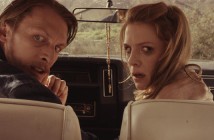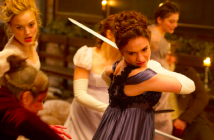
Editor’s Notes: The Wrong Man, Killer Dames, Rich Kids, A Married Woman, How to be Single, & The Chase will be released on their respective formats May 24th.
The Wrong Man

The Wrong Man (Warner Archive) features a favorite theme of director Alfred Hitchcock — an innocent man drawn into circumstances that threaten his well being. Manny Balestrero (Henry Fonda) is a nightclub bass player and family man by day. When he enters a loan office, he is accused of robbery. Evidence against him is circumstantial, and a long investigation follows. Manny is taken to various crime locations, stands in a line-up, and becomes ensnared in the bureaucratic process.
Because he has no solid alibi, Manny undergoes the agony of not knowing what will happen, fearing he might go to prison for a crime he didn’t commit. Fonda underplays, considering the anguish his character goes through. It’s as if he’s in a nightmare and is waiting for the alarm clock to ring. His Manny transforms from a regular guy to one feeling he’s lost his mooring in the real world.
Vera Miles plays Manny’s wife Rose, who suffers the ordeal along with her husband. Miles was under contract to Hitchcock and would appear in a major role in Psycho four years later. Character actor Harold J. Stone plays the methodical detective heading the case, who is portrayed as thorough, but fair. He wants to get to the truth and won’t be swayed by the incriminating evidence against Balestrero.
This was the only film Hitchcock made that was based on a true story. Shot in black and white, which provides a documentary feel, The Wrong Man was shot on location in New York City and real-life Balestrero case witnesses were featured in small roles. Made in 1956 during the run of TV’s Alfred Hitchcock Presents, the film’s style is very much like those programs, rather than the director’s lush Technicolor vehicles. For fans of Hitchcock, the movie is a curiosity. Made quickly on a small budget, it was produced between two of Hitchcock’s biggest successes — The Man Who Knew Too Much and Vertigo.
Bonus features on the Blu-ray release include the documentary Guilt Trip: Hitchcock and The Wrong Man, and the original theatrical trailer.
Killer Dames

Killer Dames (Arrow Video) is a 4-disc set of two feature films directed by Emilio P. Miraglia. The Night Evelyn Came Out of the Grave (1971) takes place in England, where Alan Cunningham (Anthony Steffen) is a wealthy aristocrat recently released from a mental institution. Haunted by the death of his first wife, Evelyn, he tries to move on by marrying the seductive Gladys (Marina Malfatti). Soon, however, several relatives meet untimely and gruesome deaths, leading to speculation that a vengeful Evelyn has risen from the grave.
In The Red Queen Kills Seven Times (1972), an ancient family curse falls on sisters Kitty (Barbara Bouchet) and Franziska (Marina Malfatti) following the death their grandfather Tobias (Rudolf Schundler). According to the curse, every hundred years the bloodthirsty Red Queen returns and claims seven fresh victims.
Both films fall within the Italian giallo genre — lurid murder mysteries with considerable female flesh on view. Their heyday was the early 1970s. The films in this box set contain a number of gruesome scenes and escalating suspense. Acting is not the best, but the style carries the day. Production design, the use of color, and atmospheric locations all contribute to an eerie mood. Both films are unrated and in the widescreen format.
There is an incredible amount of bonus material in the set, including alternate openings, archival interviews with Barbara Bouchet, Lorenzo Baralsi, Marino Masse, and Erika Blanc; new interview with Sybil Danning; new audio commentary; original Italian and English soundtracks; reversible sleeve featuring original and newly commissioned art work; and a limited edition 60-page booklet containing details of production, critical evaluation and background on the giallo genre.
Rich Kids

Rich Kids (Olive Films), set on the Upper West Side of Manhattan, finds twelve-year-old Jamie Harris (Jeremy Levy), having gone through his parents’ divorce, instructing his friend Fanny Philips (Trini Alvarado) on surviving her own parents’ imminent break-up. Drawn closer by their similar circumstances, Fanny and Jamie explore their curiosity about the opposite sex, freaking out both sets of parents.
Director Robert M. Young elicits excellent performances from the young leads, who speak like kids, not actors reciting clever dialogue. We believe their precociousness and innocence as they navigate family upheaval with surprising maturity and perspective. The humor emerges naturally and is age-appropriate. The movie captures the look and feel of New York in the 1970s and features first-rate supporting performances by John Lithgow, Olympia Dukakis, David Selby, Paul Dooley, and Irene Worth.
Rich Kids portrays its characters with sensitivity and humor. It also illustrates how examples — good and bad — are set by parents and imitated by their children.
There are no bonus features on the Blu-ray release.
A Married Woman

A Married Woman (Cohen Film Collection), directed by Jean-Luc Godard in 1964, focuses on Charlotte (Macha Meril), a young married woman who is having an affair with actor Robert (Bernard Noel) even though she is still in love with husband Pierre (Philippe Leroy). When she discovers that she is pregnant, she has to decide which man is the father and which man she will stay with. Complicating the situation: both men want to have a child with her.
Charlotte may be going through an identity crisis, but her character is so vapid and surface that it’s puzzling what Robert and Pierre see in her apart from her outward beauty. It’s tough to empathize with so dull a character. The pace is deadeningly slow, made tedious by pretentious narration, unnecessary interludes, and a parade of Charlotte’s mundane activities. Godard’s camera work and editing choices are interesting, but these characters are simply too ordinary for us to become engrossed.
The film is in French, with English subtitles. Bonus features on the Blu-ray release include 2010 interviews with French fashion designer and film producer Agnes B., Godard, scholar Antoine de Baecque, and star Macha Meril; and 2015 re-release trailer.
How to be Single

How to be Single (Warner Home Video) is a romantic comedy about young people in New York City trying to find the right match. Alice (Dakota Johnson) dumps boyfriend Josh (Nicholas Braun) to pursue the single life she feels she’s missing. Soon, however, she discovers that being single has complexities she didn’t anticipate. Though it has a bittersweet quality uncommon in movies like this, How to be Single is ultimately very silly.
Director Christian Ditter keeps on the comedy track, which results in many of the characters being dispensers of one-liners. Rebel Wilson plays sex-crazed gal pal Robin who is constantly hung over, which gives her character license to act outrageously for easy laughs. The cast also includes Leslie Mann (This Is 40), Damon Wayans, Jr. (Let’s Be Cops), Anders Holm (“Neighbors”), and Colin Jost (TV’s “Saturday Night Live”).
Many movies about young people coming to New York to live depict them finding spacious apartments with amazing views in desirable neighborhoods. If you’re from New York City, or know what apartment rents go for in New York, this immediately takes you out of the film. I suppose the art director wants everything to look elegant. A cramped studio apartment way uptown would be more appropriate for Alice’s budget.
How to Be Single is a series of vignettes that strive too hard to be funny when the basic source material isn’t there. Ms. Johnson does her best with a sub-par script dependent on crude humor.
Bonus extras on the Blu-ray release include three making-of featurettes, Rebel Wilson outtakes, deleted scenes, and gag reel.
The Chase

The Chase (Kino Lorber) is a film noir about shell-shocked ex-Navy man Chuck Scott (Robert Cummings, Saboteur), who’s been having nightmares and experiencing hard times. When he finds a wallet containing $80, he returns it to the home of wealthy businessman Eddie Roman (Steve Cochran). Impressed by Chuck’s honesty, Roman hires him as a chauffeur. Roman’s unhappy wife, Lorna (Michele Morgan), pays Chuck $1,000 to take her to Havana. When she is fatally killed in a Havana nightclub, Chuck is accused of the murder and must go on the run to prove his innocence.
Based on a novel by Cornell Woolwich, The Chase (1946) is unusual in that it is set, for the most part, in a warm, exotic, vacation locale rather than on gritty urban streets. A key dream sequence gives the movie a dark, nightmare feel, making reality and unreality indistinguishable from one other. This was hardly typical of films noir of the period, making The Chase quite distinctive.
Cummings delivers as the man in the middle of trouble, but Peter Lorre as Roman’s bodyguard steals every scene he’s in.
Special features on the Blu-ray release include audio commentary by filmmaker Guy Maddin; two radio adaptations of Cornell Woolwich’s source novel, The Black Path of Fear, starring Brian Donlevy and Cary Grant; and a selection of film noir trailers.



